There are two known classes of functions for which the Euler--Fourier formulas for the coefficients can be simplified: even and odd. We define them as follows
A function
f is
even if the graph of
f is
symmetric with respect to the
y-axis. Algebraically,
f is even if and only if
\( f(-x) = f(x) \) for all
x in the domain of
f. A function
f is
odd if the graph of
f is symmetric with respect to the origin. In other words,
f is odd if the following equation holds for all
x and
-x in the domain of
f:
\( f(-x) = -f(x) . \) Geometrically, the graph of an odd function has rotational symmetry with respect to the origin, meaning that its graph remains unchanged after rotation of 180 degrees about the origin.
Properties involving addition and subtraction:
- The sum of two even functions is even, and any constant multiple of an even function is even.
- The sum of two odd functions is odd, and any constant multiple of an odd function is odd.
- The difference between two odd functions is odd.
- The difference between two even functions is even.
- The sum of an even and odd function is neither even nor odd, unless one of the functions is equal to zero over the given domain.
Properties involving multiplication and division:
- The product of two even functions is an even function.
- The product of two odd functions is an even function.
- The product of an even function and an odd function is an odd function.
- The quotient of two even functions is an even function.
- The quotient of two odd functions is an even function.
- The quotient of an even function and an odd function is an odd function.
Properties involving composition:
- The composition of two even functions is even.
- The composition of two odd functions is odd.
- The composition of an even function and an odd function is even.
- The composition f ○ g = f(g) of any function f with an even function g is even (but not vice versa).
Other algebraic properties:
- Any linear combination of even functions is even. The set of even functions form a vector space over the real numbers ℝ. Similarly, any linear combination of odd functions is odd, and the odd functions also form a vector space over the reals. In other words, every function f(x) can be written uniquely as the sum of an even function and an odd function:
\[
f(x)=f_{\text{e}}(x)+f_{\text{o}}(x) ,
\]
where
\[
f_{\text{e}}(x)=\tfrac {1}{2} \left[ f(x)+f(-x) \right] ,
\]
is even and
\[
{\displaystyle f_{\text{o}}(x)={\tfrac {1}{2}}[f(x)-f(-x)]}
\]
is odd. For example, if \( f(x) = e^x , \) then its even part, fe, is cosh(x) and its odd part, fo, is sinh(x).
Basic calculus properties:
- The derivative of an even function is odd.
- The derivative of an odd function is even.
- The integral of an odd function from -A to +A is zero (where A is finite, and the function has no vertical asymptotes between -A and A): \( \int_{-A}^A f_{\text{o}}(x) \,{\text d}x = 0. \)
- The integral of an even function from -A to +A is twice the integral from 0 to +A (where A is finite, and the function has no vertical asymptotes between -A and A): \( \int_{-A}^A f_{\text{e}}(x) \,{\text d}x = 2 \int_0^A f_{\text{e}}(x) \,{\text d}x . \) This also holds true when A is infinite, but only if the integral converges).
Series properties:
- The Maclaurin series of an even function includes only even powers.
- The Maclaurin series of an odd function includes only odd powers.
- The Fourier series of a periodic even function includes only cosine terms.
- The Fourier series of a periodic odd function includes only sine terms.
If a function f(x) is defined on a finite interval (a,b), it can be extended periodically in three different ways:
- Periodically with period \( T= b-a . \) This can be achieved by expanding f into regular real Fourier series:
\[
f(x) \sim \frac{a_0}{2} + \sum_{n\ge 1} \left[ a_n \cos \frac{2\pi nx}{T} + b_n \sin \frac{2\pi nx}{T} \right] , \qquad a_n = \frac{2}{T} \int_T f(x) \,\cos \frac{2\pi nx}{T}\,{\text d}x , \quad b_n = \frac{2}{T} \int_T f(x) \,\sin \frac{2\pi nx}{T}\,{\text d}x ; \quad n=0,1,2,\ldots ;
\]
or complex Fourier series:
\[
f(x) \sim \sum_{n=-\infty}^{\infty} c_n e^{2{\bf j}\pi nx/T} , \qquad c_n = \frac{1}{T} \int_T f(x)\, e^{-2{\bf j}\pi nx/T} \,{\text d}x , \quad n=0, \pm 1, \pm 2, \ldots .
\]
- Periodically with period \( T= 2(b-a) = 2\ell , \) with ℓ = b−𝑎, by making the extension an even function. This can be achieved upon expanding f into Fourier cosine series:
\begin{equation} \label{EqEven.1}
f(x) \sim \frac{a_0}{2} + \sum_{n\ge 1} a_n \cos \frac{n\pi x}{\ell} , \qquad a_n = \frac{2}{\ell} \int_{0}^{\ell} f(x) \,\cos \frac{n\pi x}{\ell}\,{\text d}x ; \quad n=0,1,2,\ldots .
\end{equation}
-
Periodically with period \( T= 2(b-a) = 2\ell \) by making the extension an odd function. This can be achieved upon expanding f into Fourier sine series:
\begin{equation} \label{EqEven.2}
f(x) \sim \sum_{n\ge 1} b_n \sin \frac{n\pi x}{\ell} , \qquad a_n = \frac{2}{\ell} \int_{0}^{\ell} f(x) \,\sin \frac{\pi nx}{\ell}\,{\text d}x ; \quad n=1,2,\ldots .
\end{equation}
We demonstrate all these approaches in the following examples.
Example 1:
We start with a simple function, which is of saw-tooth type: \( g(t) = t \) on the
interval (0, π ) that we first extend periodically with period π and then expand it into regular Fourier series:
\[
f(t) = \begin{cases} t , & \quad \mbox{when $t\in (0, \pi )$, } \\
t + \pi , & \quad \mbox{when $t\in (-\pi , 0)$. } \end{cases}
\]
a0 = Integrate[t, {t, 0, Pi}]*2/Pi
ak = Simplify[
Integrate[t*Cos[k*t], {t, 0, Pi}, Assumptions -> Element[k, Integers]]/Pi +
Integrate[(t + Pi)*Cos[k*t], {t, -Pi, 0}, Assumptions -> Element[k, Integers]]/Pi ]
bk = Simplify[
Integrate[t*Sin[k*t], {t, 0, Pi}, Assumptions -> Element[k, Integers]]/Pi +
Integrate[(t + Pi)*Sin[k*t], {t, -Pi, 0}, Assumptions -> Element[k, Integers]]/Pi ]
fourier[m_] := Pi/2 + Sum[ak*Cos[k*t] + bk*Sin[k*t], {k, 1, m}]
\[
f(t) = \frac{\pi}{2} - \sum_{k\ge 0} \frac{1}{k} \left[ 1+ (-1)^k \right] \sin (kt) = \frac{\pi}{2} - \sum_{n\ge 1} \frac{1}{n} \, \sin (2n\,t) .
\]
There are three options to determine the Fourier series. First, we define a piecewise continuous function
f[t_] = Piecewise[{{t + Pi, -Pi < x < 0}, {t, 0 < t < Pi}}]
With this at hand, we can either evaluate Fourier coefficients directly
an = Assuming[Element[n, Integers],
Integrate[f[x]*Cos[n*x], {x, -Pi, Pi}]/Pi]
bn = Assuming[Element[n, Integers],
Integrate[f[x]*Sin[n*x], {x, -Pi, Pi}]/Pi]
or use standard
Mathematica command (to see 10 first coefficients)
FourierTrigSeries[f[x], x, 10]
Another option is to consider the given function of the interval (0, π):
\[
f(x) = \frac{a_0}{2} + \sum_{n\ge 1} a_n \cos (2nx) + b_n \sin (2nx) ,
\]
where
\begin{align*}
a_0 &= \frac{2}{\pi} \int_0^{\pi} t\,{\text d}t = \pi ,
\\
a_n &= \frac{2}{\pi} \int_0^{\pi} t\,cos (2nt)\, {\text d}t = 0, \qquad n> 0,
\\
b_n &= \frac{2}{\pi} \int_0^{\pi} t\,sin (2nt)\, {\text d}t = \frac{1}{n} , \qquad n=1,2,\ldots .
\end{align*}
An = 2*Integrate[t*Cos[2*n*t], {t, 0, Pi}]/Pi
Bn = 2*Integrate[t*Sin[2*n*t], {t, 0, Pi}]/Pi
Then we plot partial sums with 10 and 50 terms:
f[x_] = Piecewise[{{x, 0 < x < Pi}, {x + Pi, -Pi < x < 0}}]
Plot[{f[t], fourier[50]}, {t, -8, 8},
PlotStyle -> {{Thick, Blue}, {Thick, Red}}]
Now we extend the given function
in even way on the interval
\( (-\pi , \pi ) . \) This interval was chosen for simplicity to avoid application of option
FourierParameters that was explained in the introductory web page.
periodicExtension[func_] := func[Abs[Mod[t, 2*Pi, -1*Pi]]]
g[t_] = t
per = periodicExtension[g]
a = Plot[{g[t], per}, {t, -8, 8}, PlotStyle -> Thick,
AspectRatio -> 1]
Show[a, Graphics[{Text[Style["g(t)", FontSize -> 14, Blue], {4, 5.3}],
Text[Style["per", FontSize -> 14, Orange], {-6, 3.3}]}]]
Now we turn our attention to even extension of the given function:
\[
f_e (t) = \begin{cases} \phantom{-}t , & \quad \mbox{when $t\in (0, \pi )$, } \\
-t , & \quad \mbox{when $t\in (-\pi , 0)$. } \end{cases}
\]
Its cosine Fourier expansion is
\[
f_e (t) = \frac{\pi}{2} +\frac{2}{\pi} \, \sum_{k\ge 0} \frac{1}{k^2} \left[ (-1)^k -1\right] \cos (kt) = \frac{\pi}{2} - \frac{4}{\pi}\,\sum_{k\ge 0} \frac{1}{(2k+1)^2} \, \cos ((2k+1)t) .
\]
We plot partial cosine Fourier sums with 10 and 50 terms:
a0 = Integrate[t, {t, 0, Pi}]*2/Pi
ak = Simplify[Integrate[t*Cos[k*t], {t, 0, Pi}]*2/Pi ]
even[m_] := Pi/2 + Sum[ak*Cos[k*t], {k, 1, m}]
Plot[{even[50]}, {t, -8, 8}, PlotStyle -> {Thick, Red}]
Since the function
g(t) = t is an odd function, we apply the
Mathematica command
FourierTrigSeries[g[t], t, 5] to find its sine Fourier series approximation with 5 terms:
Out[4]= 2 Sin[t] - Sin[2 t] + 2/3 Sin[3 t] - 1/2 Sin[4 t] + 2/5 Sin[5 t]
We check the answer with manual evaluation:
bk = Integrate[t*Sin[k*t], {t, 0, Pi}]*2/Pi
Out[5]= (-2 k \[Pi] Cos[k \[Pi]] + 2 Sin[k \[Pi]])/(k^2 \[Pi])
Therefore, the odd extension of the function
g(t) becomes
\[
t = -2\,\sum_{k\ge 1} \frac{1}{k} \, (-1)^k \sin (kt) , \quad t \in (-\pi, \pi ).
\]
Then we plot sine Fourier approximations with 10 and 50 terms:
odd[m_] = -2*Sum[(-1)^k/k*Sin[k*t], {k, 1, m}]
Plot[odd[10], {t, -8, 8}, PlotStyle -> {Thick, Red}]
FourierSinCoefficient[ expr , t, n] gives the
n-th coefficient in the Fourier sine series expansion of expr.
FourierCosCoefficient[ expr , t, n] gives the
n-th coefficient in the Fourier cosine series expansion of expr.
FourierCosSeries[expr, t , n] gives the n-order Fourier cosine series expansion of expr in t.
FourierSinSeries[expr, t , n] gives the n-order Fourier sine series expansion of expr in t.
Similarly, we get sine Fourier series (Gibbs overshoot and undershoot are given explicitly):
FourierSinSeries[x, x, 50, FourierParameters -> {1, Pi/2}];
Plot[%, {x, -1.5, 3.5}, PlotStyle -> Thick, Ticks -> {{-1, 1, 3}, {2.358, -2.358}}]
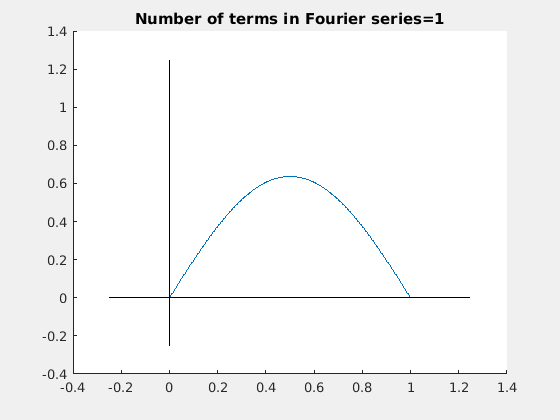
|
|
Finally, we demonstrate animation for Fourier series approximations.
s[x_, m_] = Pi/2 - Sum[Sin[2*n*x]/n, {n, 1, m}];
animation =
Table[Plot[s[x, m], {x, -0.1, Pi + 0.1}, PlotRange -> {0, 3.2},
PlotStyle -> Thickness[0.008],
PlotLabel ->
"Fourier approximation depends on " <> ToString[m] <>
" terms"], {m, 0, 100, 2}];
Export["saw.gif", animation, "AnimationRepetitions" -> 200]
|
Example 2:
Let us consider the function f(x) = x, assuming it is defined in the interval [-π , π ].
f[x_] := x
a0 = (1/Pi)* Integrate[f[x], {x, −Pi, Pi}];
an = (1/Pi)* Integrate[f[x]*Cos[n*x], {x, −Pi, Pi}, Assumptions -> Element[n, Integers]];
bn = (1/Pi)* Integrate[f[x]*Sin[n*x], {x, −Pi, Pi}, Assumptions -> Element[n, Integers]];
Print[{a0, an, bn}]
Out[5]= {0,0,(2 (-n \[Pi] Cos[n \[Pi]]+Sin[n \[Pi]]))/(n^2 \[Pi])}
Note that we used option
Assumptions to tell
Mathematica that
n is an integer. Then we define the finite sum Fourier approximation containing m terms:
fourier[m_] := a0 /2 + Sum[an Cos[n x] + bn Sin[n x], {n, 1, m}]
Plot[fourier[10], {x, -Pi, Pi}, Epilog -> Point[{{2, 2}, {-2, -2}}],
PlotStyle -> {Thick, Black}]
Now we repeat calculations with m=20 and m=50 terms:
Plot[fourier[20], {x, -Pi, Pi}, Epilog -> Point[{{2, 2}, {-2, -2}}],
PlotStyle -> Thick]
Plot[fourier[50], {x, -Pi, Pi}, Epilog -> Point[{{2, 2}, {-2, -2}}],
PlotStyle -> Thick]
Example 3:
Since the function sin(x/2) is an odd function on the interval [-π,π], we can expand it into sine Fourier series explicitly:
\[
\sin \left( \frac{x}{2} \right) \sim \frac{2}{\pi} \sum_{n\ge 1} (-1)^{n+1} \frac{n}{n^2 -1/4} \,\sin (nx) , \qquad x\in (-\pi , \pi ).
\]
We check with
Mathematica whether partial sums approximate the given function:
F[x_]=2/Pi*Sum[(-1)^(n+1)*n/(n*n-1/4) * Sin[n*x] , {n,1,30}];
Plot[{Sin[x/2], F[x]}, {x,-5,5}, PlotStyle->Thick]
We can also expand the given function sin(x/2) into cosine Fourier series by expanding it to negative semi-axis in even way. First, we calculate Fourier coefficients:
a0=2/Pi*Integrate[Sin[x/2], {x,0,Pi}];
an= Simplify[2/Pi*Integrate[Sin[x/2]*Cos[n*x], {x,0,Pi}]];
4/\[Pi]
(4 - 8 n Sin[n \[Pi]])/(\[Pi] - 4 n^2 \[Pi])
This gives us the following cosine Fourier series:
\[
\sin \left( \frac{x}{2} \right) \sim \frac{2}{\pi} - \frac{4}{\pi} \sum_{n\ge 1} \frac{1}{4n^2 -1} \, \cos (nx) , \qquad x\in [-\pi , \pi ] .
\]
F[x_]= 2/Pi - 4/Pi*Sum[1/(4*n*n-1) * Cos[n*x], {n,1,30}];
Plot[{Sin[x/2], F[x]}, {x,-5,10}, PlotStyle->Thick]
So the partial sum with 30 terms gives a very good approximation for the function sin(
x/2) on the interval [0,π].
■
Example 4:
Now we use cosine and sine Fourier series for the
half-wave rectifier of function
f(x) = 1-x:
\[
f(x) = \begin{cases} 1-x , & \ \mbox{ if } 0 < x < 1, \\
0, & \ \mbox{ if } 1 < x < 2. \end{cases}
\]
Let us start with cosine series, which gives even periodic expansion of the given function:
f[x_] = Piecewise[{{1 - x, 0 < x < 1}, {0, 1 < x < 2}}];
FourierCosSeries[f[x], x, 3]
out[10]= 1/(2 \[Pi]) + (4 Cos[x] Sin[1/2]^2)/\[Pi] + (
Cos[2 x] Sin[1]^2)/\[Pi] + (4 Cos[3 x] Sin[3/2]^2)/(9 \[Pi])
coscurve5Pi=FourierCosSeries[f[x], x, 5];
Plot[coscurve5Pi, {x, -1.5, 3.5}]
then with 50 terms:
coscurve50Pi=FourierCosSeries[f[x], x, 5];
Plot[coscurve50Pi, {x, -1.5, 3.5}]
Then we repeat these calculation for cosine series on the interval of length 2:
FourierCosSeries[f[x], x, 5, FourierParameters -> {1, Pi/2}];
Plot[%, {x, -1.5, 3.5}]
We can also find sine Fourier series for this piecewise function.
f[x_] = Piecewise[{{1 - x, 0 < x < 1}, {0, 1 < x < 2}}];
FourierSinSeries[f[x], x, 25, FourierParameters -> {1, Pi/2}];
Plot[%, {x, -1.5, 3.5}, PlotStyle->Thick, PlotRange->{-1.1,1.1}]
■
We consider two examples for derivations of trigonometric identities using
Fourier series expansions.
Example 5A:
We are going to prove the well-known trigonometric identity:
\[
\cos^2 x = \frac{1+ \cos 2x}{2} .
\]
Since the cosine function is an even periodic function with the fundamental
period 2π, we expand its product with itself into cosine Fourier series
\[
\cos^2 x = \frac{a_0}{2} + \sum_{k\ge 1} a_k \cos \left( \frac{k\pi x}{L}
\right) , \qquad \mbox{with } L = \pi .
\]
The Euler-Fourier coefficients are determined with
Mathematica:
f[x_] = (Cos[x])^2
L=Pi
a0 = 2/L*Integrate[f[x], {x, 0, L}]
ak = 2/L*Integrate[f[x]*Cos[x*k*Pi/L], {x, 0, L}]
(2 (-2 + k^2) Sin[k \[Pi]])/(k (-4 + k^2) \[Pi])
Since sin
kπ = 0 for any integer
k, all coefficients
\( a_k = 0 \) except
k = 2, which we
calculate separately:
a2 = 2/L*Integrate[f[x]*Cos[x*2*Pi/L], {x, 0, L}]
1/2
Therefore, the Fourier expansion of the function cos² contains only two
nonzero terms corresponding to
k = 0 and
k = 2. This proves the
identity above.
However, we notice that cos² is actually a periodic function with period
π, so we can find its cosine Fourier series with 2 L = π:
\[
\cos^2 x = \frac{a_0}{2} + \sum_{k\ge 1} a_k \cos \left( \frac{k\pi x}{L}
\right) , \qquad \mbox{with } L = \pi /2.
\]
Mathematica helps:
L=Pi/2
a0 = 2/L*Integrate[f[x], {x, 0, L}]
ak = 2/L*Integrate[f[x]*Cos[x*k*Pi/L], {x, 0, L}]
(4 Sin[k \[Pi]])/((4 k - 4 k^3) \[Pi])
This yields
\[
\cos^2 x = \frac{1}{2} + \sum_{k\ge 1} \frac{2 \, \sin k\pi}{k \left( k-1 \right)\left( k+1 \right) \pi} \cos \left( 2k\pi x
\right) .
\]
Again, the coefficient
\( a_1 \) should be calculated separately because it is undefined as 0/0.
a1 = 2/L*Integrate[f[x]*Cos[x*1*Pi/L], {x, 0, L}]
1/2
So we again obtain the correct answer.
Now we consider another function that coincides with cos²x on the
interval (-π,π):
\[
f_1 (x) = \begin{cases}
-\cos^2 x , & \ \pi /2 \le x \le \pi , \\
\phantom{-}\cos^2 x , & \ -\pi /2 \le x \le \pi /2 , \\
-\cos^2 x , & \ -\pi \le x \le -\pi /2 .
\end{cases}
\]
We expand this even function defined on the interval (-π,π) into Fourier
series
\[
f_1 (x) = \sum_{n\ge 0} a_n \cos \left( n\pi x \right) ,
\]
where
\( a_0 =0 \) and
\[
a_n = \frac{2}{\pi} \int_0^{\pi /2} \cos^2 x\,\cos \left( n\, x \right)
{\text d}x - \frac{2}{\pi} \int_{\pi /2}^{\pi} \cos^2 x\,\cos \left( n\, x
\right) {\text d}x = - \frac{4}{\pi}\,\frac{\sin n\pi /2}{n \left( n-2 \right) \left( n+2 \right)}
\]
because
an = Integrate[f[x]*Cos[n*x], {x, 0, Pi/2}] -
Integrate[f[x]*Cos[n*x], {x, Pi/2, Pi}]
-((2 Sin[(n \[Pi])/2])/(-4 n + n^3)) - (
2 Sin[(n \[Pi])/2] + (-2 + n^2) Sin[n \[Pi]])/(n (-4 + n^2))
Finally, we get
\[
f_1 (x) = - \frac{4}{\pi} \sum_{k\ge 0} \frac{2\, (-1)^k}{\left( 2k+1
\right)\left( 2k-1 \right)\left( 2k+3 \right)} \, \cos \left( 2k+1 \right) x .
\]
Therefore, we have two Fourier representations for the same function
cos²
x on the interval (−π, π) but with respect to different
sets of cosine functions. Finally, we plot cos²
x along with 10-term
cosine Fourier approximation to the function
f1(
x).
F[x_] = - (4/Pi)*
Sum[2*(-1)^k *Cos[(2*k + 1)*x]/(4*k^2 - 1)/(2*k + 3), {k, 0, 10}]
a = Plot[{F[x], (Cos[x])^2}, {x, -4, 4}, PlotStyle -> Thick]
text1 = Graphics[
Text[Style["\!\(\*SubscriptBox[\(f\), \(1\)]\)(x)", FontSize -> 14,
Black], {1.4, -0.6}]]
text2 = Graphics[
Text[Style["\!\(\*SuperscriptBox[\(cos\), \(2\)]\)(x)",
FontSize -> 14, Black], {1.6, 0.6}]]
Show[a, text1, text2]
 Plot of cos²x and 10-term cosine Fourier approximation to f1.
Plot of cos²x and 10-term cosine Fourier approximation to f1.
Example 5B:
Now we derive the identity:
\[
\cos^3 x = \frac{\cos 3x + 3\, \cos x}{4} .
\]
First, we start with cosine Fourier series on the interval (−π, π):
\[
\cos^3 x = \sum_{k\ge 1} A_k \cos \cos \left( \frac{k\pi x}{L}
\right) , \qquad \mbox{with } L = \pi .
\]
The Euler-Fourier coefficients are determined with
Mathematica:
g[x_] = (Cos[x])^3;
L = Pi
a0 = 2/L*Integrate[g[x], {x, 0, L}]
ak = 2/L*Integrate[g[x]*Cos[x*k*Pi/L], {x, 0, L}]
a2 = 2/L*Integrate[g[x]*Cos[x*2*Pi/L], {x, 0, L}]
-((2 k (-7 + k^2) Sin[k \[Pi]])/((9 - 10 k^2 + k^4) \[Pi]))
These coefficients are all zeroes except values where the denominator vanishes.
So we find its roots:
Solve[9 - 10 k^2 + k^4 == 0, k]
{{k -> -3}, {k -> -1}, {k -> 1}, {k -> 3}}
So we need to recalculate coefficients corresponding to indices
k = 1
and 3.
a1 = 2/L*Integrate[g[x]*Cos[x*1*Pi/L], {x, 0, L}]
a3 = 2/L*Integrate[g[x]*Cos[x*3*Pi/L], {x, 0, L}]
3/4
1/4
Therefore, we get
\[
\cos^3 x = \frac{3}{4}\,\cos x + \frac{3}{4}\, \cos 3x .
\]
Now we repeat calculations for the cosine Fourier series on the interval
(0,π/2).
\[
\cos^3 x = \frac{A_0}{2} + \sum_{k\ge 1} A_k \cos \cos \left( 2k\pi x
\right) , \qquad A_k = \frac{4}{\pi} \int_0^{\pi /2} \cos^3 x\,
\cos \left( 2k\pi x \right) {\text d}x .
\]
L = Pi/2
a0 = 2/L*Integrate[g[x], {x, 0, L}]
ak = 2/L*Integrate[g[x]*Cos[x*k*2], {x, 0, L}]
(24 Cos[k \[Pi]])/((9 - 40 k^2 + 16 k^4) \[Pi])
The denominator vanishes for noninteger values:
Solve[9 - 40 k^2 + 16 k^4 == 0, k]
{{k -> -(3/2)}, {k -> -(1/2)}, {k -> 1/2}, {k -> 3/2}}
We conclude that
\[
\cos^3 x = \frac{4}{3\pi} + \frac{24}{\pi} \sum_{k\ge 1}
\frac{(-1)^k}{9-40 k^2 + 16 k^4} \,\cos \left( 2k\pi x \right) .
\]
So we obtained two cosine Fourier series for cos
3x on
the interval (-π/2,π/2).
■
Example 6:
We consider a step function f(x) = 1 on the unit interval [0, 1] that is extended outside in odd manner:
\[
f(x) = \begin{cases}
\phantom{-}1, & \ \mbox{ for } 0 < x < 1, \\
-1, & \ \mbox{ for } -1 < x < 0.
\end{cases}
\]
We expand this function into sine Fourier series (because the function is odd) by evaluating its Euler--Fourier coefficients
\[
b_n = 2 \int_0^1 \sin (n\pi x)\,{\text d}x = \frac{2}{n\pi} \left[ 1 - (-1)^n \right] .
\]
Integrate[Sin[n*Pi*x], {x, 0, 1}]*2
(2 (1 - Cos[n \[Pi]]))/(n \[Pi])
Therefore, the corresponding sine Fourier sine is
\[
f(x) = \sum_{n\ge 1} \frac{2}{n\pi} \left[ (-1)^{n+1} + 1 \right] \sin (n\pi x) = \frac{4}{\pi} \sum_{k\ge 0} \frac{1}{2k+1} \,\sin \left( (2k+1) \pi x \right) .
\]
Its Fourier series exhibits the Gibbs phenomenon at points of discontinuity
x = 0 and
x = 1. For its regularization, we apply Cesàro's summation:
\[
f_m (x) = \frac{4}{\pi} \sum_{k= 0}^m \left( 1 - \frac{k}{m+1} \right) \frac{1}{2k+1} \,\sin \left( (2k+1) \pi x \right) .
\]
clear all
clc
tic
range = [-2, 2];
x = range(1):0.001:range(2);
x = x';
y = sign(x);
[a10,b10,y10] = series(x,y,10);
[a100,b100,y100] = series(x,y,100);
[a1000,b1000,y1000] = series(x,y,1000);
figure
hold on
plot(x,y100, 'LineWidth', 1.5, 'DisplayName', '100 Term Fourier Series')
plot(x,y10, 'LineWidth', 1.5, 'DisplayName', '10 Term Fourier Series')
xlim(range)
axes1 = gca;
%setting labels and making graph more legible
title('Signum Function and Fourier Series');
xlabel({'x'},'FontName','Times New Roman');
ylabel({'y'},'FontName','Times New Roman');
set(axes1,'FontName','Times New Roman','FontSize',16,'XGrid','on','YGrid','on');
legend1 = legend(axes1,'show');
set(legend1,'Location','best');
hYLabel = get(gca,'YLabel');
set(hYLabel,'rotation',0,'VerticalAlignment','middle')
hold off
figure
hold on
plot(x,y1000, 'LineWidth', 1.5, 'DisplayName', '1000 Term Fourier Series')
plot(x,y10, 'LineWidth', 1.5, 'DisplayName', '10 Term Fourier Series')
xlim(range)
axes1 = gca;
%setting labels and making graph more legible
title('Signum Function and Fourier Series');
xlabel({'x'},'FontName','Times New Roman');
ylabel({'y'},'FontName','Times New Roman');
set(axes1,'FontName','Times New Roman','FontSize',16,'XGrid','on','YGrid','on');
legend1 = legend(axes1,'show');
set(legend1,'Location','best');
hYLabel = get(gca,'YLabel');
set(hYLabel,'rotation',0,'VerticalAlignment','middle')
hold off
toc
function [a,b,yfit] = series(x,y,n)
x1 = min(x);
x2 = max(x);
x = pi*(2*(x-x1)/(x2-x1) - 1);
nx = x*(1:n);
F = [0.5*ones(size(x)),cos(nx),sin(nx)];
c = F\y;
a = c(1:n+1);
b = c(n+2:end);
yfit = F*c;
end
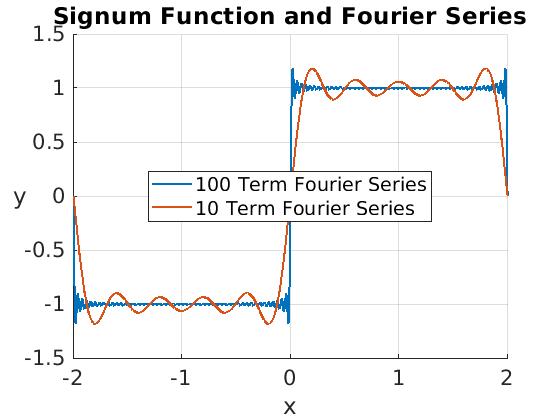
|
|
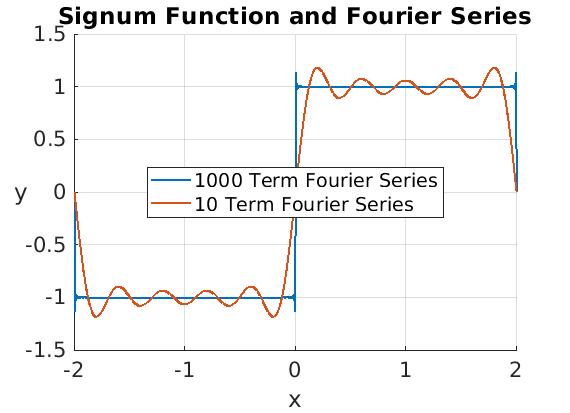
|

|
|
Finally, we demonstrate animation for Cesàro's approximation
s[x_, m_] =
4*Sum[(1 - k/(m + 1))*Sin[(2*k + 1)*Pi*x]/(2*k + 1), {k, 0, m}]/Pi;
animation =
Table[Plot[s[x, m], {x, -0.1, 1.1}, PlotRange -> {-0.2, 1.2},
PlotStyle -> Thickness[0.008],
PlotLabel -> "Sine Fourier approximation"], {m, 0, 100, 2}];
Export["sine.gif", animation, "AnimationRepetitions" -> 200]
|
|
Cesàro's approximation with m = 40 terms
|
|
Mathematica code.
|
■
Example 7:
We consider an integrable function that does not satisfy the Dirichlet conditions and for which we don't have sufficient conditions that guarantee pointwise convergence of the corresponding Fourier series (which is actually the Fourier sine series because the function is odd).
\[
f(x) = \sin \left( \frac{1}{x} \right) , \qquad -\ell < x < \ell .
\tag{7.1}
\]
This function belongs to 𝔏²(−ℓ, ℓ) for any positive ℓ. For simplicity, we set ;ℓ = 1 and get
f[x_] = Sin[1/x]
N[Integrate[f[x]^2, {x,-1,1}]]
1.3469135365315457
\[
\int_{-1}^1 f^2 (x)\,{\text d}x =\int_{-1}^1 \sin^2 \left( \frac{1}{x} \right) \,{\text d}x \approx 1.3469135365315457 .
\]
We formally expand this function into Fourier sine series
\[
\sin \left( \frac{1}{x} \right) = \sum_{n\ge 1} b_n \sin \left( \pi x \right) ,
\]
where coefficients
\[
b_n = 2 \int_0^1 \sin \left( \frac{1}{x} \right) \sin \left( \pi x \right) {\text d} x , \qquad n= 1 ,2 , 3, \ldots ,
\]
can be evaluated only numerically.
clear all
clc
tic
range = [0.0005, 0.5];
x = range(1):0.00005:range(2);
x = x';
y = sin(1./x);
[a10,b10,y10] = series(x,y,10);
[a100,b100,y100] = series(x,y,100);
[a1000,b1000,y1000] = series(x,y,1000);
figure
plot(x,y, 'LineWidth', 1.5, 'DisplayName', 'sin(1/x)')
hold on
plot(x,y10, 'LineWidth', 1.5, 'DisplayName', '10 Term Fourier Series')
xlim(range)
ylim([-1.5 2.0])
axes1 = gca;
%setting labels and making graph more legible
title('sin(1/x) and Fourier Series');
subtitle('Wide Domain')
xlabel({'x'},'FontName','Times New Roman');
ylabel({'y'},'FontName','Times New Roman');
set(axes1,'FontName','Times New Roman','FontSize',16,'XGrid','on','YGrid','on');
legend1 = legend(axes1,'show');
set(legend1,'Location','best');
hold off
figure
plot(x,y, 'LineWidth', 1.5, 'DisplayName', 'sin(1/x)')
hold on
plot(x,y10, 'LineWidth', 1.5, 'DisplayName', '10 Term Fourier Series')
xlim([0.02, 0.2])
ylim([-1.5 2.0])
axes2 = gca;
%setting labels and making graph more legible
title('sin(1/x) and Fourier Series');
subtitle('Small Domain')
xlabel({'x'},'FontName','Times New Roman');
ylabel({'y'},'FontName','Times New Roman');
set(axes2,'FontName','Times New Roman','FontSize',16,'XGrid','on','YGrid','on');
legend2 = legend(axes2,'show');
set(legend2,'Location','best');
hold off
figure
plot(x,y, 'LineWidth', 1.5, 'DisplayName', 'sin(1/x)')
hold on
plot(x,y100, 'LineWidth', 1.5, 'DisplayName', '100 Term Fourier Series')
xlim(range)
ylim([-1.5 2.0])
axes1 = gca;
%setting labels and making graph more legible
title('sin(1/x) and Fourier Series');
subtitle('Wide Domain')
xlabel({'x'},'FontName','Times New Roman');
ylabel({'y'},'FontName','Times New Roman');
set(axes1,'FontName','Times New Roman','FontSize',16,'XGrid','on','YGrid','on');
legend1 = legend(axes1,'show');
set(legend1,'Location','best');
hold off
figure
plot(x,y, 'LineWidth', 1.5, 'DisplayName', 'sin(1/x)')
hold on
plot(x,y100, 'LineWidth', 1.5, 'DisplayName', '100 Term Fourier Series')
xlim([0.02, 0.2])
ylim([-1.5 2.0])
axes2 = gca;
%setting labels and making graph more legible
title('sin(1/x) and Fourier Series');
subtitle('Small Domain')
xlabel({'x'},'FontName','Times New Roman');
ylabel({'y'},'FontName','Times New Roman');
set(axes2,'FontName','Times New Roman','FontSize',16,'XGrid','on','YGrid','on');
legend2 = legend(axes2,'show');
set(legend2,'Location','best');
hold off
figure
plot(x,y, 'LineWidth', 1.5, 'DisplayName', 'sin(1/x)')
hold on
plot(x,y1000, 'LineWidth', 1.5, 'DisplayName', '1000 Term Fourier Series')
xlim(range)
ylim([-1.5 2.0])
axes1 = gca;
%setting labels and making graph more legible
title('sin(1/x) and Fourier Series');
subtitle('Wide Domain')
xlabel({'x'},'FontName','Times New Roman');
ylabel({'y'},'FontName','Times New Roman');
set(axes1,'FontName','Times New Roman','FontSize',16,'XGrid','on','YGrid','on');
legend1 = legend(axes1,'show');
set(legend1,'Location','best');
hold off
figure
plot(x,y, 'LineWidth', 1.5, 'DisplayName', 'sin(1/x)')
hold on
plot(x,y1000, 'LineWidth', 1.5, 'DisplayName', '1000 Term Fourier Series')
xlim([0.02, 0.2])
ylim([-1.5 2.0])
axes2 = gca;
%setting labels and making graph more legible
title('sin(1/x) and Fourier Series');
subtitle('Small Domain')
xlabel({'x'},'FontName','Times New Roman');
ylabel({'y'},'FontName','Times New Roman');
set(axes2,'FontName','Times New Roman','FontSize',16,'XGrid','on','YGrid','on');
legend2 = legend(axes2,'show');
set(legend2,'Location','best');
hold off
figure
hold on
plot(x,y-y1000, 'LineWidth', 1.5, 'DisplayName', '1000 Term Fourier Series Error')
plot(x,y-y100, 'LineWidth', 1.5, 'DisplayName', '100 Term Fourier Series Error')
plot(x,y-y10, 'LineWidth', 1.5, 'DisplayName', '10 Term Fourier Series Error')
xlim([0.01, 0.1])
ylim([-1.5 2.0])
axes2 = gca;
%setting labels and making graph more legible
title('Error for the Fourier Series');
subtitle('Very Small Domain')
xlabel({'x'},'FontName','Times New Roman');
ylabel({'y'},'FontName','Times New Roman');
set(axes2,'FontName','Times New Roman','FontSize',16,'XGrid','on','YGrid','on');
legend2 = legend(axes2,'show');
set(legend2,'Location','best');
hold off
toc
function [a,b,fourier] = series(x,y,n)
x1 = min(x);
x2 = max(x);
x = pi*(2*(x-x1)/(x2-x1) - 1);
nx = x*(1:n);
F = [0.5*ones(size(x)),cos(nx),sin(nx)];
c = F\y;
a = c(1:n+1);
b = c(n+2:end);
fourier = F*c;
end
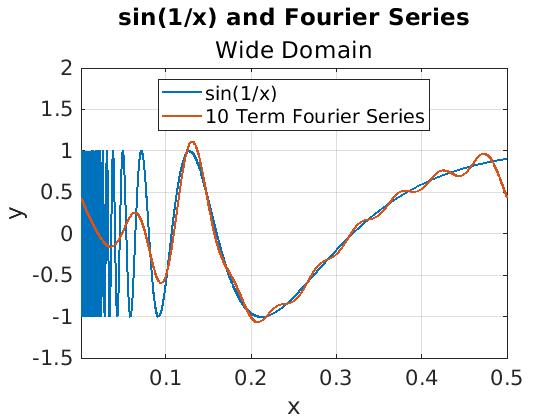
|
|
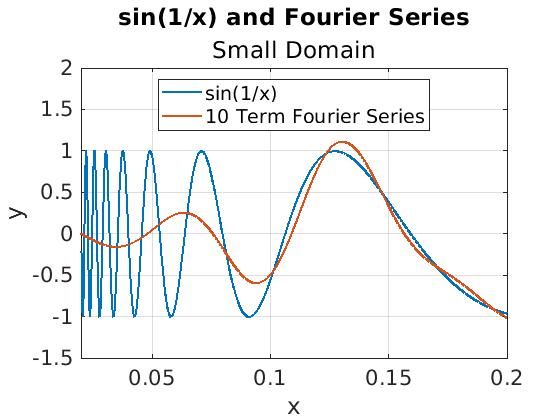
|
|
Fourier approximation with 10 terms on interval [0, 1].
|
|
Fourier approximation with 10 terms near the origin.
|
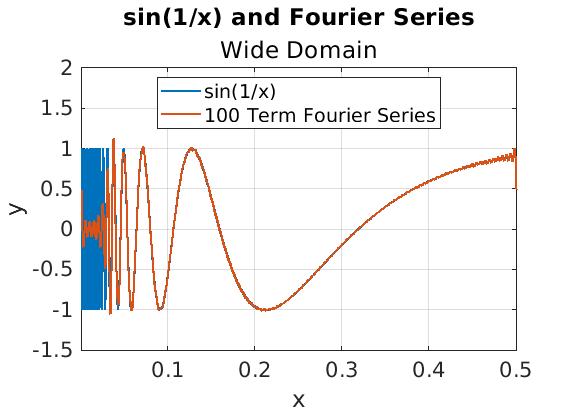
|
|
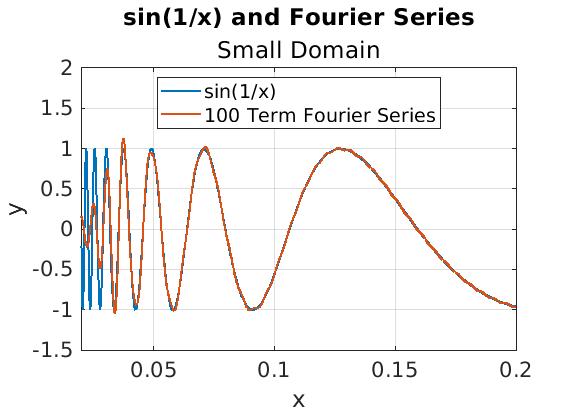
|
|
Fourier approximation with 100 terms on interval [0, 1].
|
|
Fourier approximation with 100 terms near the origin.
|

|
|
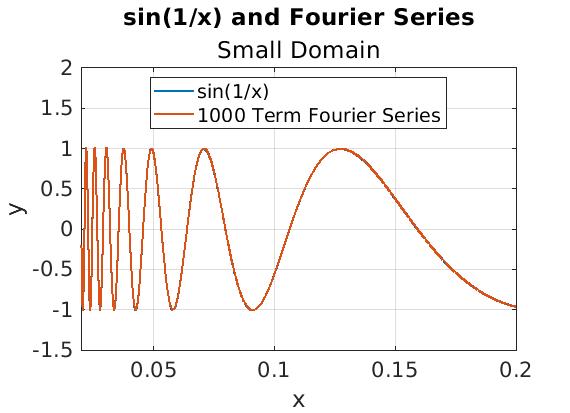
|
|
Fourier approximation with 1000 terms on interval [0, 1].
|
|
Fourier approximation with 1000 terms near the origin.
|
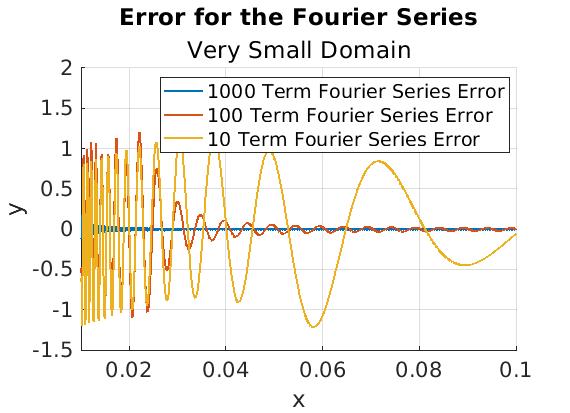 Errors of Fourier approximations
Errors of Fourier approximations
■